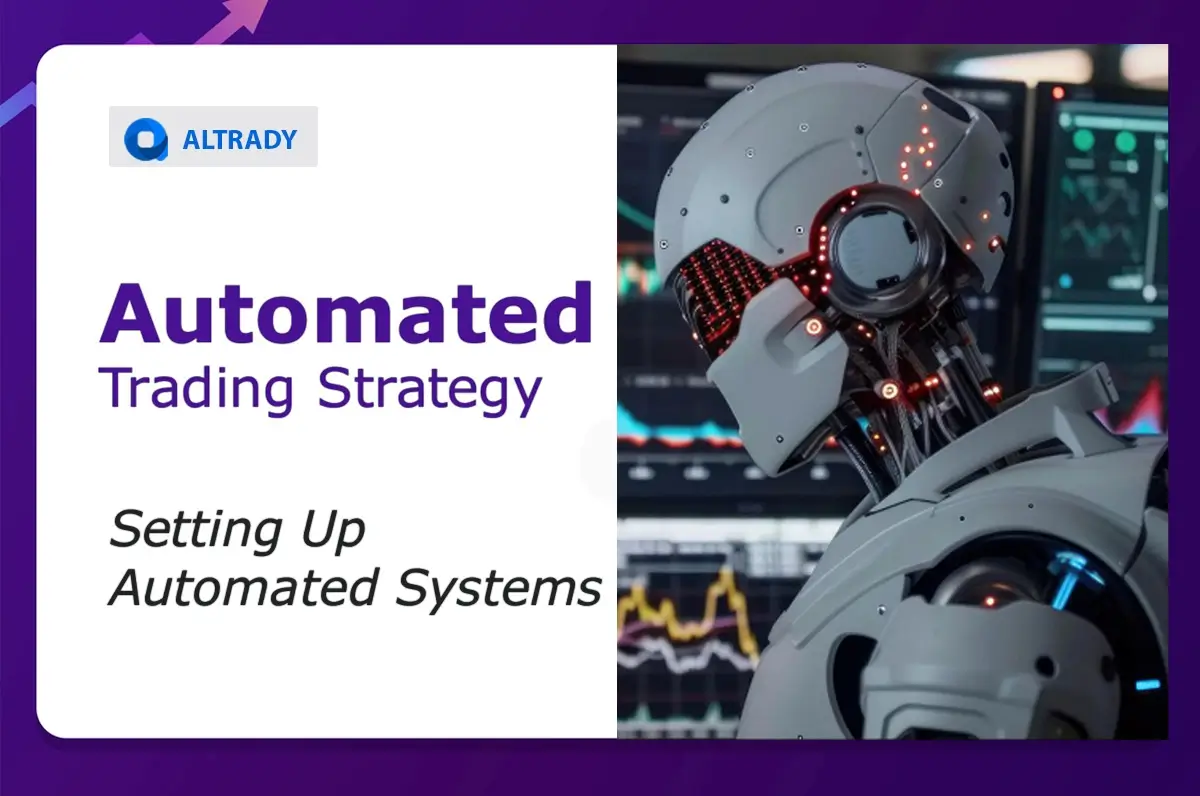Category List


Automated Trading Strategy: Setting Up Automated Systems
Automated trading systems are sophisticated methods to involve in the crypto market, they can help traders stick to their strategies and take advantage of market opportunities with speed and precision.
In this article, we will explore the process of setting up automated systems and discuss some best practices for developing a successful trading strategy.
Understanding Automated Trading
Automated strategies in trading involve executing trades in the absence of the trader, and instead by following instructions crafted by the operator to provide to a specific system, like a bot. These strategies are highly correlated to algorithmic trading approaches, where computer systems take a relevant placement.
Executing trades automatically provides traders with benefits that can enhance their trading journey. We can remark on some of them such as follows:
- Reduce the stress caused by trading live.
- Avoid psychological biases.
- Avoid overtrading.
- Spend less time in front of charts.
- Dedicate more time to analyzing trading performance.
- Improve the consistency.
However, automation in trading also demands some other aspects to be fulfilled by the trader:
- Crafting a trading plan based on the chosen strategy.
- Gathering data resulting from conducting research.
- Technical analysis where traders determine relevant zones or price action patterns that will be performed by the automated system.
- Fundamental analysis to understand the events influencing the price of crypto assets, such as the improvements or issues facing the project, economic news, etc.
For an advanced approach to algorithms, then traders would need technical skills like:
- Programming
- Data analysis
However, in today's realm, there are plenty of options to set up automated systems in the absence of technical skills. Platforms like Altrady let traders leverage trading automation without depending on programming skills or advanced data analysis. But it is also true that getting the best results with automation will demand mastering charting tools, price action analysis, and a wide range of trading strategies.
Setting Up Automated Systems: Trading Plan And First Steps
The fundamental part of this type of trading procedure is to automatically place buy or sell orders based on predefined criteria. Setting up an automated trading strategy involves several key steps, from defining the correct trading objectives to selecting the right platform for testing and running algorithms.
Overall, successful automation requires:
- Careful planning.
- Research and testing to develop a robust and profitable system.
- Defining trading objectives.
- Developing a solid algorithm.
- Testing and optimizing the system.
- Monitoring performance.
All of those requirements must be crafted in a trading plan. So, how do traders create a curated trading plan?
Traders need to:
- Select a trading strategy such as trend trading, breakout, or range strategies.
- Define risk size per trade, for example, 1% over the capital.
- Analyze the chart to define high-probability setups based on trading concepts like support/resistance or technical indicators signals.
- Define entry and exit criteria.
Let's see an example
Example of a trading plan
| STRATEGY | TREND TRADING |
|---|---|
| RISK TOLERANCE | 2% PER TRADE |
| TRADING STYLE | INTRADAY |
| ASSET | BITCOIN |
| SESSION HOURS | NEW YORK |
| ENTRY SIGNALS | 1. PRICE MOMENTUM AFTER AN ENGULFING PATTERN 2. HIDDEN DIVERGENCE SPOTTED BY RSI 3. MACD CROSSOVER 4. PRICE ACTION DURING A PULLBACK IN FAVOR OF THE PREVAILING DIRECTION WITH MOVING AVERAGES CONFLUENCE. 5. PULLBACK TOWARD THE 50% FIBONACCI RETRACEMENT |
| EXIT | 1. PLACE A STOP LOSS OF NO MORE THAN 2%. 2. TRAILING STOP OF 0.5% ACCORDING TO THE POSITION PERFORMANCE. |
| RISK AND TRADING POLICIES | 1. DO NOT EVER TRADE AGAINST THE TREND 2. DEFINE CRITERIA FOR THE AUTOMATED SYSTEM TO SEEK ENTRIES WITH HIGH PROBABILITIES. IN THIS SENSE, IDENTIFY KEY LEVELS IN THE TREND 3. DO NOT BREAK THE AUTOMATED SYSTEM CRITERIA EARLY, INSTEAD BACKTEST, OPTIMIZE, AND GIVE TIME FOR THE SYSTEM TO PERFORM AND DETERMINE WHETHER IT IS SUCCESSFUL OR NOT. SEEK CONSISTENCY. |
Now, with a trading plan already defined, let's dive into the following sections to understand how to set up an automated system.
Define Trading Objectives
It is essential to determine the trading objectives of the system and establish a clear set of rules for the strategy to implement.
By distinctly defining the objectives and risk parameters, traders can approach a more effective and efficient trading strategy.
Choose The Platform
The next step is to choose the right platform for implementing the automated system.
There are many trading platforms available in the market as we mentioned in the beginning. Altrady is a perfect option for crypto traders.
Considering factors such as ease of use of the trading terminal, customization options, backtesting features, and technical support is crucial when selecting a platform that best suits the automated system needs.
Algorithm Development
Building an effective trading algorithm is a vital step for an automated trading strategy. The algorithm must integrate technical indicators, price action patterns, and risk management rules to generate trade signals.
It is necessary to backtest the algorithm comparing the results against historical market data to evaluate the performance and optimize its parameters before deploying it in a live trading account.
Testing And Optimizing
It is crucial to test and optimize the algorithm and the strategy to guarantee its effectiveness in different market conditions.
By using a demo account or paper trading traders can simulate real market conditions and estimate the performance of the automated system.
Key metrics such as win rate, drawdown, and Sharpe ratio will be valuable pieces to identify areas for improvement and necessary adjustments to enhance the profitability of the strategy
MonitorIng The System
When deploying the automated trading system, it is necessary to monitor its performance regularly and make adaptations as it demands.
Stay informed about market trends, news events, and economic indicators that can impact further trades. The Altrady's market explorer can help traders achieve that task.
Conclusion
Automated trading systems can be a powerful way to strive for success in crypto trading at the time that traders reduce stress and improve consistency.
Despite the technical requirements that building automated trading systems can imply, it is popular among traders looking to execute trades efficiently, and platforms like Altrady offer a free trial account that can help traders achieve the best results along a vast range of features.





























